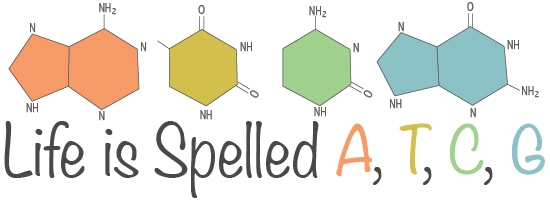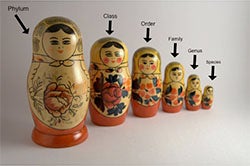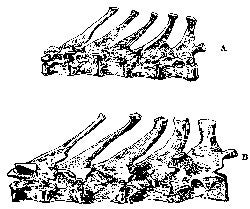
Backbone genomes
 Russian dolls consist of several dolls nested inside one another. One large doll opens to reveal a smaller doll. This smaller doll opens to reveal an even smaller doll, and so on. Groups of organisms are a bit like these Russian dolls. They can be included in large groups with many other organisms, but are nested into several groups of different sizes, leading down to the smallest doll, which is a single species.
Russian dolls consist of several dolls nested inside one another. One large doll opens to reveal a smaller doll. This smaller doll opens to reveal an even smaller doll, and so on. Groups of organisms are a bit like these Russian dolls. They can be included in large groups with many other organisms, but are nested into several groups of different sizes, leading down to the smallest doll, which is a single species.
A species is a group of closely related organisms and is one of the smallest units with which we classify life. You can think of a species as the smallest doll inside all the others. Closely related species are then put into a series of larger groups. Humans belong to a large group of animals known as vertebrates. Vertebrates have backbones that protect their spinal cords. On the other hand, invertebrates (insects, flatworms, and roundworms) are animals that do not have this trait.
 Humans and other mammals are vertebrates. So are fishes, frogs, crocodiles, snakes, lizards, turtles, and birds. Overall, there are at least 77,500 vertebrate species. However, telling all the differences between these species is difficult. Only a handful of species have had their genomes sequenced. This is because genome sequencing is relatively new. It is also expensive.
Humans and other mammals are vertebrates. So are fishes, frogs, crocodiles, snakes, lizards, turtles, and birds. Overall, there are at least 77,500 vertebrate species. However, telling all the differences between these species is difficult. Only a handful of species have had their genomes sequenced. This is because genome sequencing is relatively new. It is also expensive.
As of 2015, scientists have sequenced the genomes of 560 animals. Plants and fungi have far fewer sequences done. Out of the animals, over half are invertebrate species. The remaining animals are vertebrates. Most vertebrate genome sequences (over 100) come from mammals. But some are also available for other vertebrate species. These include two amphibians, 63 birds, 55 fishes, and ten reptiles.
Humans are a type of vertebrate. Therefore, we can find our place on the tree of life by looking at vertebrate genetics.
Be Part of
Ask An Anthropologist
By volunteering, or simply sending us feedback on the site. Scientists, teachers, writers, illustrators, and translators are all important to the program. If you are interested in helping with the website we have a volunteers page to get the process started.

